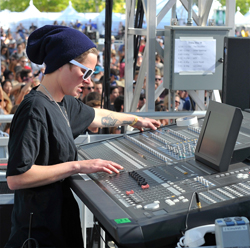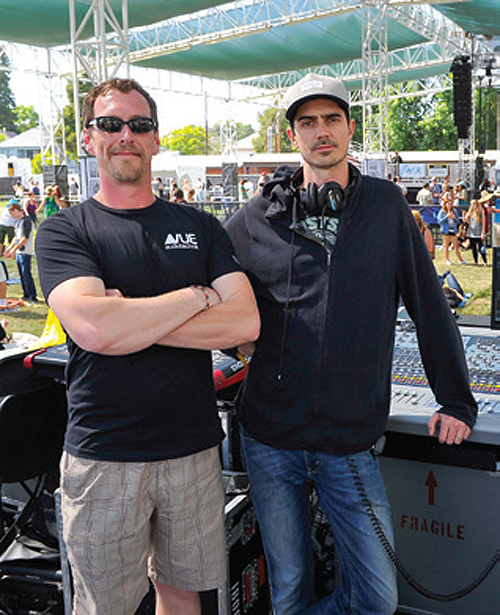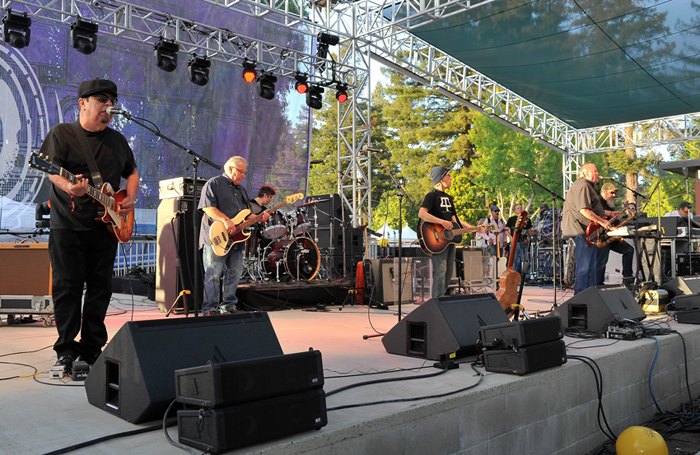
At the Winery Stage, the gear broke down further like this: al-4 cabinets deployed in mono arrays for front fill and under hangs, four h-12N stereo side fills, four powered, wide-throw h-12W enclosures on a yoke system serving the VIP punter section running on a matrix from front of house, and a half-dozen hs-25 subs lined up in front of the stage. Wedges onstage were hm-212 models.
Working from an Avid VENUE Profile console, Delicate’s Sebastian Poux was the house mixer for the stage, stage and monitor tech was Jake Gowalsky. A DiGiCo SD9 console was supplied at FOH for guest mix engineers.
Monitorworld events were orchestrated by the capable of hands of Lindsay Smith, who had a Yamaha PM5D-RH console at her disposal.
Turn & Burn
Edwards reports that the SystemVUE network control and monitoring package interfaced neatly with Delicate’s own Lake primary front end.
“We tweaked the rig with Jeff (Taylor) for 20 minutes and we were done,” he says. “The network package handled crossover points, everything you’d expect. When guest engineers arrived, we’d hand them a tablet with a flat curve and let them build what they wanted.
“When you’re dealing with eight bands per day on a single stage, you don’t want to have to give them an education, you just want to turn and burn,” he continues. “We had all kinds of engineers pass through over the course of the festival. Sixty-year-old veterans would just hand us a thumb drive and say ‘here’s my starting point, you tweak the rig for me,’ and then we’d have young guys who want to play with everything. Everyone on the planet has used a Lake, so it was seamless from one act to the next.”
Audio power for the stage arrived in the form of VUE V6 (house) and V4 (monitors) amp rack engines. The V6s offer stereo triamplification, while the V4s deliver stereo biamplification.
Input was all Delicate-supplied, with the bulk of the microphones being hardwired. Only four channels of Shure wireless were kept at hand, while the rest of the input list read like a typical stage pack with e609 and other Sennheiser offerings for guitars and horns, and Shure SM57s, BETA 98s and 52s for drums.
Rolling risers facilitated the fast-paced tempo of the shows. With sets going from 40 minutes to an hour and getting longer as the headlining acts approached, acts were turned-over in 20 minutes with the help of four local union stagehands.
Jeremy French was the stage manager for the rolling parts of the stage (“the El Jefe of all moves” in Edwards’ words), most of the acts were sound checked and had their settings stored into the desk, but as can be expected, travel times and delays prohibited others from affording this luxury.
“This system did everything we expected it to do and then some,” Edwards says. “You can always take this stuff and set it up back in your warehouse, throw some compressed playback through it like everyone’s old Steely Dan CDs or some MP3s we’ve all been using for 100 years, and you’ll only hear so much. There is no substitute for taking something out and putting it in front of an endless stream of bands for three days and seeing what it does.
“We saw a lot of talented engineers put this rig through its paces at BottleRock, including our own Sebastian Poux. The results made everyone happy. No matter how long you’ve been doing this, every year you learn more and get a little better. That’s how life is supposed to work, right?”


